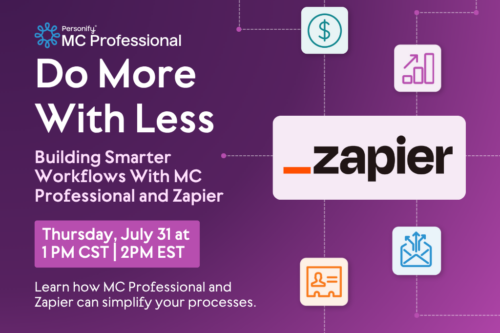Make no mistake. Those planning on attending a conference, meeting, or other events are about to go on a journey. The question is whether that journey will be a pleasant experience that exceeds expectations or one that is filled with barriers, disappointment, and poor ratings. The difference could be a well-planned and executed attendee journey map.
In this article we will address what an attendee’s journey map is, and the steps involved in creating one. You’ll learn about how valuable the map can be and why it is well worth the additional effort. We will provide tips on following your map and validating its effectiveness. We will explore the best practices to use when creating an attendee journey map and the important role empathy can play in its creation.
Get ready to take the next step in planning and executing successful events that excel.
What is an Attendee Journey Map?
The attendee event experience is what happens to an attendee before, throughout, and following an event. An event attendee journey map plots out the various scenarios attendees may face and lays out a detailed plan for the most enjoyable and efficient experience for them.
In creating an attendee journey experience map, an organizer or planner may more clearly see potential problematic areas in their event stages and minimize any barriers or problem areas. By asking, “How can this part of the experience be improved?” the planners’ focus turns to proactively improving the experience.
This process of looking for potential barriers along with possible areas of improvement through each step of the attendee’s experience helps ensure a successful event.
While both you and your attendees may get to your destination without mapping the attendee journey, creating and utilizing the mapping process can make sure you are both on track to a successful event without bumps in the road and without getting sidetracked.
Key Stages of an Attendee Journey Map
Like mileposts or landmarks along the highway, there are key stages in creating an attendee journey map.
These three key stages before, during, and after the event each have their own critical touchpoints to use in the creation of your positive and efficient attendee journey map.
Pre-Event
It can be a mistake to minimize the importance of the pre-event experience for potential attendees. It can significantly impact the number of registrations, anticipation, and expectations for your event.
Research:
What similar events have taken place in the past, and what contributed to their success (or failure)? Research comments on these events and build upon the positives in creating your attendee journey map.
Invitations:
What are ways you can reach potential attendees? Beyond your member list, consider influencers, social media, and contacts from sponsors. Can you incentivize early sign-ups through discounts or referral perks? Ensure initial and early communications convey a positive, enticing message.
The Registration Process:
Take the steps necessary to ensure your registration process is simple, barrier-free, and streamlined. Include an automatic confirmation message and let attendees know of the next steps.
Pre-Event Engagement:
Pre-event communications are critical in maintaining anticipation and excitement for your event while communicating important event information. Engage attendees frequently, using as many digital vehicles as possible. Use videos, social media, emails, video conferencing, and virtual tours. Highlight keynote speakers and presentations.
Promote learning sessions and networking opportunities. Tease new products and technology. Reassure the registrants they made a good decision and encourage them to spread the word. You can also use polls and surveys to engage attendees in advance of your event. Encourage questions and answer them quickly and visibly.
During the Event
Much of the onsite experience can be enhanced through technology and by placing yourself in the shoes of attendees every step of the way.
Make Attendees Comfortable.
One of the best ways to make attendees comfortable from the start is to have clear signage announcing the location of your event and where attendees should sign in. Use automated registration if possible, and consider using an event app to stay in touch. Get sufficient staff who can anticipate common questions. Understand that while your staff may go through repeated similar steps, attendees only check in once.
Maintain Attendee Engagement.
Take advantage of as many engagement opportunities as possible. Avoid losing connection with attendees. Use an event attendee app, social media, forums, and instant messaging to maintain contact. Make sure attendees have plenty of opportunities and vehicles to express any concerns in real time.
Facilitate Networking.
Remember the importance of networking in the attendee journey. Provide multiple and varied opportunities to network, including post-session gatherings, social areas, social events, social media, and even fun events like “speed networking.” You not only want to engage attendees; you also want to promote their engagement with each other. Provide plenty of opportunities.
Post-Event
Even after your event ends, the attendee experience journey continues. Attendees now have an opportunity to better absorb what they experienced and how they feel about it. Just as important, they have an opportunity to judge their experience as a success or a disappointment. Take steps to follow through and follow up with attendees.
Thank You’s:
There will be time for a more elaborate expression of gratitude later, but it is important to recognize and thank attendees for their support immediately. A quick post-event text or email of thanks is a good place to start.
Surveys:
Some of the most valuable feedback you can get may be that submitted closest to the event. Have a post-event survey ready to present to attendees. Let them know their input is valuable in shaping future events. Allow for open-ended feedback. Be prepared to address any severe criticism immediately and with empathy.
Adding Post-Event Value:
This can be accomplished in a variety of ways, including event photos and comments. Make recorded sessions available for streaming to attendees. Include brief video interviews of speakers and presenters sharing experiences from their point of view. Share success stories from vendors. This all tends to add value to your event, even following its conclusion.
Long-Term Engagement:
One of the most valuable aspects of conducting a successful event is the long-term relationships, engagements, and benefits it can provide.
This is an opportunity to stay engaged with a group of interested people who have already sampled your product. They not only can be a source of valuable data but can also serve as your brand ambassadors. Nurture these contacts through long-term engagement like polls, surveys, and exclusive content. They are potentially your first-class
Steps to Create an Effective Attendee Journey Map
Like any journey, a successful attendee experience should be taken one step at a time. Here are six steps in creating an effective attendee journey map.
Step 1: Define Goals and Objectives
Determining the goals and objectives is the initial step in crafting a successful attendee journey map. Define the main goal of your event and what it is you want attendees to get from it. Knowing exactly where you want to get to is crucial in establishing the best way to get there.
It can help to set goals for each part of the journey so your progress and success can be better gauged along the way. Know what your desired outcome is at the outset.
Step 2: Understand Your Audience
Build upon data you may already have on potential attendees by conducting research. Include demographic info like age, gender, education level, and experience. Find out what they may desire from your event and what their expectations are. What products and technology do they have an interest in?
You may be able to segment attendees into multiple groups by creating more detailed attendee journeys for maximum appeal.
The more you know about your potential attendees, the better you will be able to design a map to maximize their journey experience.
Step 3: Identify Touchpoints
From start through post-event activities, your attendees will experience many touchpoints where they come in contact with your event. Define these touchpoints and list them in order when creating your map. These are critical moments of expectation for your attendees and should be areas of focus for you and your team.
Ensure your attendees have plenty of opportunities to ask questions, make changes, and express concerns along the way. Stay connected with them.
Step 4: Plan Engagement Strategies
Take the time to create engagement strategies for each touchpoint, or milepost, along the journey. Use a poll or survey. Offer a speaker bio or video interview. Answer FAQs. Keep the lines of communication open, and welcome and invite feedback. Address any anticipated issues early.
Your event itself should be loaded with touchpoints and engagement ideas.
There should be plenty of opportunities for feedback and interaction.
Step 5: Implement and Monitor
Not only is it important to implement your attendee journey map, but to monitor its effectiveness. Monitor your attendee experience through engagement and technology. If you use an event management forum, message board, or social media, you will have a front-row seat to what is going on at ground level and if it meets your expectations and those of your attendees. Note areas of greatest success as well as those that may require improvement.
Step 6: Post-Event Analysis
Talk to attendees and get their real-time feedback. Follow up after the event with conversations and surveys. Perform a post-event analysis with staff and venue staff. Look for both positive and negative common denominators, and how well you performed with your touchpoints and engagement.
Encourage return of post-event surveys.
Use this valuable data and insights to help guide future events and build stronger and more effective attendee journey maps.
You not only want to grade your event but also how effective you were in building and following your attendee journey map.
Best Practices for Creating an Attendee Journey Map
Here are some valuable tips to keep in mind when creating an effective journey map for attendees to your next event.
Use Empathy
When planning an event, it can be easy to get lost in your own problems and concerns. It takes an ability to be empathetic to create an effective attendee journey map. What are the potential roadblocks an attendee may encounter? How can you help them solve them?
Go, step-by-step, through what marketing materials they may see and what they will be faced with when registering. What happens at check-in, and what are potential touchpoints that may cause frustration? Place yourself in their position as a paying customer with their own expectations.
Stay Flexible
It may take a long time to create a detailed attendee journey map, but that does not mean you still won’t encounter roadblocks and detours. Be flexible and be ready to adapt to your changes. You may even decide to adjust the map as you gain more data throughout your event. Don’t be afraid to use trending feedback to make adjustments.
Leverage Technology
Event management software, apps, and other technological tools can help you leverage the power of your attendee journey map and even help in its creation. From automating the registration process and streamlining check-in to engaging attendees and post-event surveys, software can help you maximize your personpower and increase your odds of success.
Focus on Communication
An event attendee journey can be easily derailed by a lack of communication or total miscommunication. Keep communications clear, concise, and timely through every stage. This is another area that can be enhanced through the use of event planning and management technology.
Summary
Customer journeys have been planned and mapped in the commercial service and retail industries for years. It is now securing its place for organizations that are planning events.
In summary, an event attendee journey map takes a close look at the three main stages of an event; pre-planning, the event itself, and post-event. It involves detailing the “touchpoints” in those stages and looking for potential problems and opportunities as the attendee moves through these stages.
It is a detailed, proactive way to anticipate issues and find solutions before they turn into problems. It also allows planners to ask, “Is there a better way?” when handling touchpoints.
The result is, hopefully, a streamlined, efficient map in which an event can be planned and the attendee experience maximized.
An attendee journey map places the emphasis on the attendee experience, the primary way most events are judged.
The Technological Help You Deserve
We encourage you to try attendee journey mapping for yourself. Experiment and share your experiences. Whether yours is a small or large organization, and you are still using spreadsheets, or you’re dipping your toes in member management or event management and planning software, MemberClicks is here to help. We offer a range of innovative software solutions that can streamline your processes and maximize the use of your data and staff.
From registration through communications and post event surveys, we can handle it all. We invite you to learn how you can take your event to the next level and beyond with a free trial. Contact us at MemberClicks for your test drive.
















